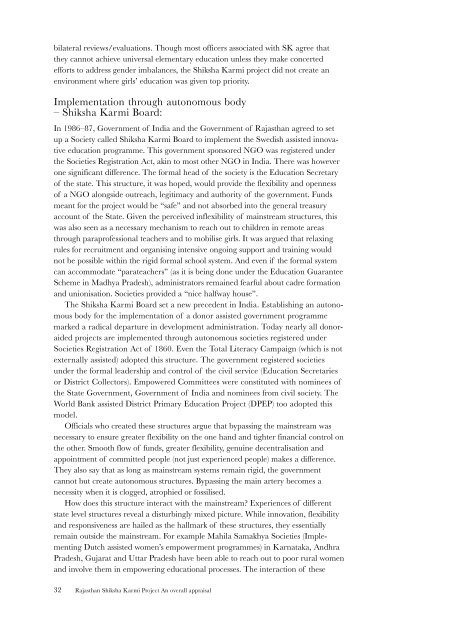Rajasthan Shiksha Karmi Project An overall appraisal
Rajasthan Shiksha Karmi Project An overall appraisal
Rajasthan Shiksha Karmi Project An overall appraisal
You also want an ePaper? Increase the reach of your titles
YUMPU automatically turns print PDFs into web optimized ePapers that Google loves.
ilateral reviews/evaluations. Though most officers associated with SK agree thatthey cannot achieve universal elementary education unless they make concertedefforts to address gender imbalances, the <strong>Shiksha</strong> <strong>Karmi</strong> project did not create anenvironment where girls’ education was given top priority.Implementation through autonomous body– <strong>Shiksha</strong> <strong>Karmi</strong> Board:In 1986–87, Government of India and the Government of <strong>Rajasthan</strong> agreed to setup a Society called <strong>Shiksha</strong> <strong>Karmi</strong> Board to implement the Swedish assisted innovativeeducation programme. This government sponsored NGO was registered underthe Societies Registration Act, akin to most other NGO in India. There was howeverone significant difference. The formal head of the society is the Education Secretaryof the state. This structure, it was hoped, would provide the flexibility and opennessof a NGO alongside outreach, legitimacy and authority of the government. Fundsmeant for the project would be “safe” and not absorbed into the general treasuryaccount of the State. Given the perceived inflexibility of mainstream structures, thiswas also seen as a necessary mechanism to reach out to children in remote areasthrough paraprofessional teachers and to mobilise girls. It was argued that relaxingrules for recruitment and organising intensive ongoing support and training wouldnot be possible within the rigid formal school system. <strong>An</strong>d even if the formal systemcan accommodate “parateachers” (as it is being done under the Education GuaranteeScheme in Madhya Pradesh), administrators remained fearful about cadre formationand unionisation. Societies provided a “nice halfway house”.The <strong>Shiksha</strong> <strong>Karmi</strong> Board set a new precedent in India. Establishing an autonomousbody for the implementation of a donor assisted government programmemarked a radical departure in development administration. Today nearly all donoraidedprojects are implemented through autonomous societies registered underSocieties Registration Act of 1860. Even the Total Literacy Campaign (which is notexternally assisted) adopted this structure. The government registered societiesunder the formal leadership and control of the civil service (Education Secretariesor District Collectors). Empowered Committees were constituted with nominees ofthe State Government, Government of India and nominees from civil society. TheWorld Bank assisted District Primary Education <strong>Project</strong> (DPEP) too adopted thismodel.Officials who created these structures argue that bypassing the mainstream wasnecessary to ensure greater flexibility on the one hand and tighter financial control onthe other. Smooth flow of funds, greater flexibility, genuine decentralisation andappointment of committed people (not just experienced people) makes a difference.They also say that as long as mainstream systems remain rigid, the governmentcannot but create autonomous structures. Bypassing the main artery becomes anecessity when it is clogged, atrophied or fossilised.How does this structure interact with the mainstream? Experiences of differentstate level structures reveal a disturbingly mixed picture. While innovation, flexibilityand responsiveness are hailed as the hallmark of these structures, they essentiallyremain outside the mainstream. For example Mahila Samakhya Societies (ImplementingDutch assisted women’s empowerment programmes) in Karnataka, <strong>An</strong>dhraPradesh, Gujarat and Uttar Pradesh have been able to reach out to poor rural womenand involve them in empowering educational processes. The interaction of these32 <strong>Rajasthan</strong> <strong>Shiksha</strong> <strong>Karmi</strong> <strong>Project</strong> <strong>An</strong> <strong>overall</strong> <strong>appraisal</strong>












